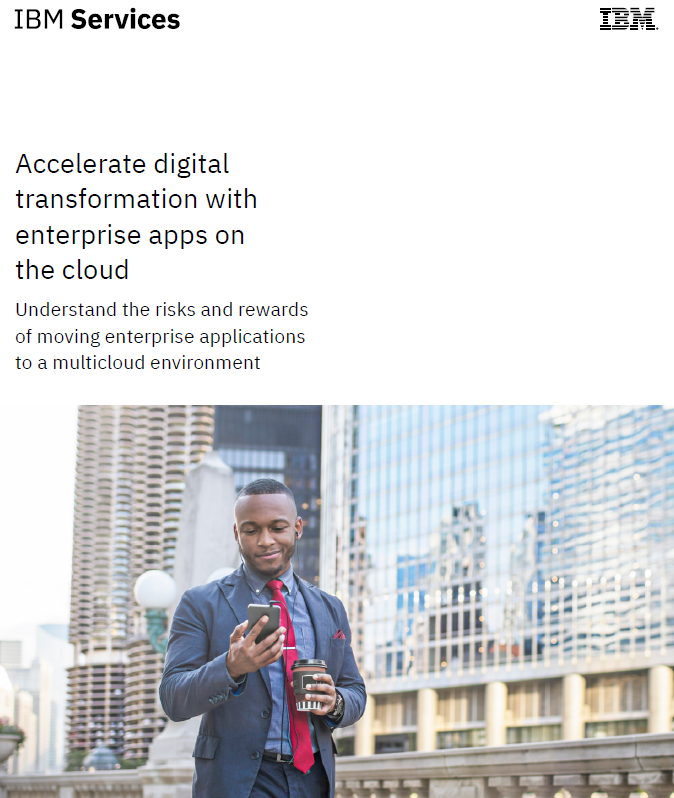How can the cloud industry adapt to a post-COVID world?
The coronavirus pandemic has fuelled rapid growth across the cloud industry, but it won’t last forever


The coronavirus pandemic has led to huge business transformations, which have proven a challenge to some organisations and a boon to others. One beneficiary has definitely been the cloud industry, which has seen huge growth over 2020 and beyond.
RELATED RESOURCE

Security analytics for your multi-cloud deployments
IBM Security QRadar SIEM solution brief
Cloud services have been a major driver of the mass shift to remote working that enabled many businesses to minimise the disruption caused by the closure of offices. So, while the economic downturn has affected many industries, cloud service providers have performed relatively well thanks to the increased demand for their products.
Companies will understandably be reluctant to claim that they have profited from the terrible impact of COVID, but some have experienced a huge boost in demand. Zoom and Microsoft Teams were among those that have had a surge in usage and revenue, with the latter reporting that it had surpassed 44 million users as early as March 2020. Many businesses have taken the opportunity to accelerate digital transformation projects over this period, with engineers more than capable of carrying out projects at pace and scale – even across the traditionally lethargic public sector.
But as these successes have been driven by COVID, the industry will sooner or later have to address what the future holds once their services are no longer in such high demand.
Shifting sands
While we all rejoiced at the news that a potential COVID-19 vaccine would be available for distribution before the end of 2020, shares in a handful of companies dropped sharply in response, including a 15% reduction in the valuation of Zoom.
Whether things go back to the way they were, or cloud companies continue to play a more pivotal role than ever, is yet to be determined. For independent cloud consultant Danielle Royston, the goal of going ‘back to normality’ in 2021 is misplaced.
“There’s no point wasting time and energy trying to return to the halcyon days of pre-COVID,” she says. “Let’s focus instead on some of the positive ‘disruptions’ we’ve seen [in 2020]. In all the companies I’ve been at, I’ve promoted – and in some cases fully converted to – remote working. I saw this as the inevitable direction that work and society was going, as the cloud computing tools were already there. And it makes sense: A better quality of life for employees, ease of collaboration, cutting the costs of business travel.”
Get the ITPro daily newsletter
Sign up today and you will receive a free copy of our Future Focus 2025 report - the leading guidance on AI, cybersecurity and other IT challenges as per 700+ senior executives
This is a trend that Tom Wrenn, cloud investment expert and partner at private equity firm ECI Partners, predicts will continue well into 2021, telling IT Pro that COVID-19 forced many companies into rapidly adopting cloud-based operations. These, driven by government-enforced lockdowns, allowed them to continue operating remotely. “Now, having done a basic shift to cloud-based systems,” he adds, “2021 will be the year of full cloud adoption, with businesses starting to optimise all its benefits; for example, data analytics and AI. If rapid investment was needed in 2020, this year businesses will want to see a return on that investment and will expect to see more from their cloud computing providers.”
Remoting-in
Although the recent transition to remote working is a trend sparked by COVID-19, the consensus is that it’s the beginning of a wider cultural shift. Former IBM boss Ginni Rometty is among the latest to suggest as much, claiming mass remote working will continue in some form as part of a broader hybrid model in future. This may involve companies keeping some physical presence while establishing the infrastructure and equipment to allow workers to work remotely as and when desired.
Cisco CTO for UK and Ireland, Chintan Patel, agrees, telling IT Pro that remote working gained widespread acceptance during COVID-19, even in organisations where it was unthinkable before. This means cloud and software as a service (SaaS) tools will continue to remain a crucial part of many setups, even though businesses will mostly return to a form of ‘hybrid’ model. “For remote working, cloud plays a central role; think secure cloud-based collaboration, accessing cloud-based business applications, and extending the security perimeter to thousands of devices,” he explains. “It’s important to note, though, that cloud-based consumption models are not limited to remote working only. As to those returning to the offices, we see technology can help make the workplace more secure and efficient. As and when companies prepare for a return to office, they also need to optimise their space, address worker concerns about sanitation and social distancing and plan how to communicate policies and information clearly.”
RELATED RESOURCE

Accelerate digital transformation with enterprise apps on the cloud
The risks and rewards of moving enterprise applications to a multi-cloud environment
Technology will play a major part in instigating the changes needed in future, with a key role to play for many of the firms that have enjoyed success during the pandemic. While demand for software such as video conferencing platforms may not be as sky-high as it was at the beginning of the pandemic, Wrenn argues the next big step is how cloud companies can eat further into the market share enjoyed by the traditional telephone industry. “More and more businesses are using Microsoft Teams or Zoom to interact,” he explains, “when previously they would have used conference lines or even called a person directly due to it being more convenient. Cloud providers need to think about how they can make the most of this opportunity as the way in which people interact changes.”
To infinity and beyond
To some extent, we should all consider ourselves lucky the global pandemic happened when it did, given that cloud computing has only in recent recently become as advanced as it is now. Thus, rather than ‘profiting from the pandemic’, this period has been the making of the industry. After all, “cloud storage, processing, and compute facilities are already set up, and ready to expand easily and automatically, as and when enterprises need,” according to Royston, who claims this wouldn’t have been the case ten to 15 years go. “It would’ve been an epic failure and caused even more disruption and long-term damage to global economies. This year, white-collar workers being able to quickly adapt to working from home in their millions is part of what’s helped many sectors stay afloat. And it’s because of the investment and ongoing work of hyperscalers over the past few years that’s meant businesses can support workers in doing this.”
RELATED RESOURCE

The IT Pro Podcast: A post-COVID cloud future
COVID has rewritten the rulebook for businesses - but will it last?
Connectivity, too, will continue to grow as organisations’ reliance SaaS tools increases too, Patel adds, with firms expecting more from these companies beyond provision. With cloud infrastructures becoming increasingly diverse, especially with applications adding more layers of complexity, businesses will be looking to strengthen their infrastructure. This will be achieved by gaining deeper visibility across their IT estates, ensuring workloads have continuous access to required resources and running systems that connect and protect at scale - from on-prem to hybrid cloud configurations. This is in addition to using technologies such as machine learning to give customers tools to manage their ever-growing data lakes. This is where providers can step in to guide customers on their migration journeys.
As such, the greatest challenge facing cloud providers, in light of the above, will largely be customer retention, according to Tom Wrenn. “If we take online meeting services as an example, historically businesses would have had to invest in a service, such as [Cisco] WebEx, which is often costly and comes with a lot of equipment,” he says. “Today, however, businesses are using Zoom and Teams for this and can just turn services on and off with little upfront investment. This means that customers aren’t locked into providers in a way they once were. As a result, cloud computing providers will need to over-deliver for their clients, retaining a high level of customer service as well as ensuring that service levels don’t decline as they undergo a huge period of growth.”

Keumars Afifi-Sabet is a writer and editor that specialises in public sector, cyber security, and cloud computing. He first joined ITPro as a staff writer in April 2018 and eventually became its Features Editor. Although a regular contributor to other tech sites in the past, these days you will find Keumars on LiveScience, where he runs its Technology section.
-
 DocuWare CEO Michael Berger on the company’s rapid growth
DocuWare CEO Michael Berger on the company’s rapid growthNews ChannelPro sat down with DocuWare CEO Michael Berger to discuss the company's rapid growth and channel strategy.
By Bobby Hellard Published
-
 Seized database helps Europol snare botnet customers in ‘Operation Endgame’ follow-up sting
Seized database helps Europol snare botnet customers in ‘Operation Endgame’ follow-up stingNews Europol has detained several people believed to be involved in a botnet operation as part of a follow-up to a major takedown last year.
By Emma Woollacott Published
-
 How COVID accelerated Kreston Reeves’ agile transformation
How COVID accelerated Kreston Reeves’ agile transformationCase Studies The pandemic has been a catalyst for hardware renewal, cloud migration, collaboration and much more
By Adam Shepherd Published
-
 Assessing your cloud strategy after COVID
Assessing your cloud strategy after COVIDIn-depth Is the cloud still the perceived panacea that delivers cost reductions, efficiency gains and a platform for businesses to thrive post-COVID?
By David Howell Published